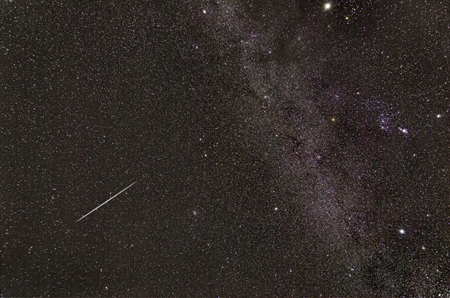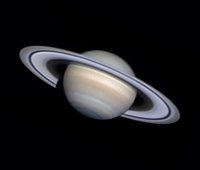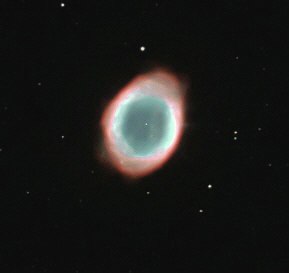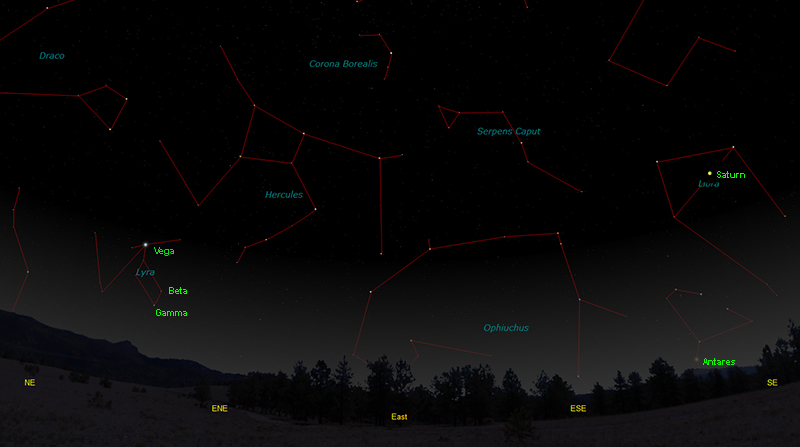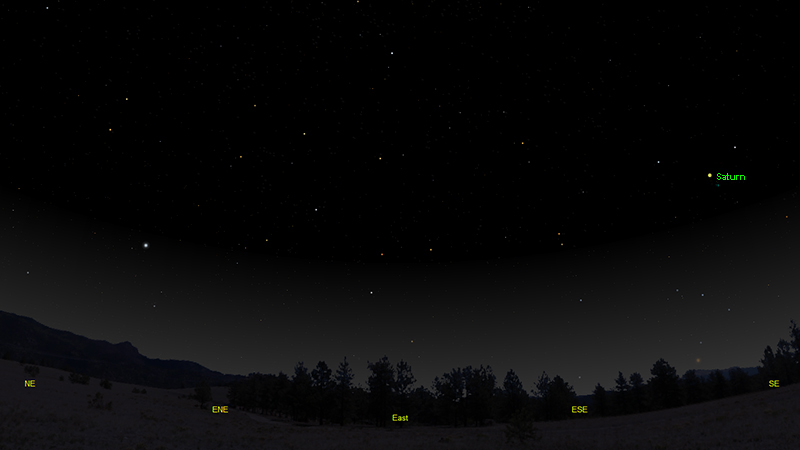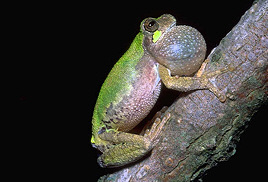The purpose of this feature is to give scout leaders, educators and naturalists an idea of some of the natural events coming up each month. We will try to cover a variety of natural events ranging from sky events to calling periods of amphibians, bird and mammal watching tips, prominent wildflowers and anything else that comes to mind. We will also note prominent constellations appearing over the eastern horizon at mid-evening each month for our area for those who would like to learn the constellations. If you have suggestions for other types of natural information you would like to see added to this calendar, let us know! Note: You can click on the hyperlinks to learn more about some of the featured items. To return to the Calendar, hit the "back" button on your browser, NOT the "back" button on the web page. All charts are available in a "printer friendly" mode, with black stars on a white background. Left clicking on each chart will take you to a printable black and white image. Please note that images on these pages are meant to be displayed at 100%. If your browser zooms into a higher magnification than that, the images may lose quality. Though we link book references to nationwide sources, we encourage you to support your local book store whenever possible. Notes and Images From April 2014
I have to apologize for taking so long to get the May 2014 Natural Calendar up. Family obligations and the amount of time taken in building the new observatory have left very little time for anything else. At right the new observatory is shown in its current stage of construction. The top view shows the observatory with the roof closed. The bottom view shows it with the roof open. We haven't framed in the door yet, but that will be done soon. So far, the observatory has performed very well in testing, with the interior staying dry during thunderstorms, but having enough ventilation through the passive roof vent to keep in within a few degrees of ambient temperature on hot days.
The outside of the observatory is covered with tongue and groove cedar siding which took quite a bit of time to install. However many of the mornings spent in construction were pleasantly cool, and it was fun to keep track of the arriving spring migrants and nesting birds while I worked. We have had Prairie Warblers, Blackpolls, Nashville Warblers, Common Yellowthroat, Blue-winged Warblers, Palm Warblers, Scarlet and Summer Tanagers, Blue and Rose-breasted Grosbeaks, and many more. Probably the most vocal of our nesting birds has been the Yellow-breasted Chat. Singing both day and night, it's constantly varying song is always entertaining. It's been called the "clown of the woods" and the "buffoon of the briar patch". Another nickname is the "choo-choo" bird, which comes from a couple of it's vocalizations that suggest the sound of a steam locomotive. On a much smaller scale, I have had several species of jumping spiders check me out as I worked on the observatory. They are to the spider world what hummingbirds are to the bird world - tiny and brilliantly colored works of art. Unfortunately, my schedule did not allow me to do much photography as I worked. But they added a lot to my enjoyment of the experience. Sky Events for May 2014:
You may want to set your alarm clock for the early morning hours of Saturday, May 24th. On that date Earth passes through the debris of Comet 209P/LINEAR , a comet discovered on February 3rd, 2004. There is a chance that this shower could produce a high rate of meteors around the peak time around 2:00am CDT on May 24, plus or minus a half hour. Some could be fireballs. The radiant of the shower, the place in the sky where the meteors will appear to stream from, will be about a third of the way from Polaris, the North Star, to the nose of Ursa Major. For those unfamiliar with the constellations, just face north. There is a lot of uncertainty whether the shower will create an impressive display. It could produce relatively few bright meteors. But then again, it could be spectacular. I'm definitely getting up andspending some time outside in the morning hours of the 24th. Evening Sky: Jupiter is low in the western sky in Gemini at dusk at the beginning of the month. Binoculars, if held steady, will show the four Galilean moons when they are not transiting the planet or being eclipsed. Mars is past its close approach to Earth and is now growing smaller in the eyepiece. It still shines brightly in Virgo, however. It's about 50 degrees above the southern horizon at dusk. With patience, you can still still a good bit of detail telescopically.
Saturn rises around 6:45pm CDT in Libra. To get the best telescopic views wait until the planet has climbed high in the sky. Mercury reaches greatest elongation from the Sun after sunset this month on May 25th. Look for it low in the West-Northwest beginning about 30 minutes after sunset. Morning Sky: Venus continues to shine brightly in the dawn sky during May. Look for it about 12 degrees above the horizon about 30 minutes before sunrise.
Constellations: The views below show the sky looking east at dusk on May 20th. The first view shows the sky with the constellation outlined and names depicted. Star and planet names are in green. Constellation names are in blue. The second view shows the same scene without labels. New constellations this month in the eastern sky are Lyra, the Lyre, with it's bright star Vega, Serpens Caput, the head of the Serpent, and Libra, the Scales. The red giant Antares (the name means Rival of Mars) is just making its way over the eastern horizon in Scorpius. Ophiuchus, the Serpent Bearer, is also climbing into view. Wait until Lyra is high in the sky, and then see if you can spot Messier 57, the Ring Nebula. Look for it a little over half the way from Gamma Lyra to Beta Lyra. A three inch aperture telescope will show this planetary nebula, which looks like a ghostly smoke ring. For more on the nebula, see here.
On Learning the Constellations: We advise learning a few constellations each month, and then following them through the seasons. Once you associate a particular constellation coming over the eastern horizon at a certain time of year, you may start thinking about it like an old friend, looking forward to its arrival each season. The stars in the evening scene above, for instance, will always be in the same place relative to the horizon at the same time and date each May. Of course, the planets do move slowly through the constellations, but with practice you will learn to identify them from their appearance. In particular, learn the brightest stars (Like Vega and Antares in the above scene looking east), for they will guide you to the fainter stars. Once you can locate the more prominent constellations, you can "branch out" to other constellations around them. It may take you a little while to get a sense of scale, to translate what you see on the computer screen or what you see on the page of a book to what you see in the sky. Look for patterns, like the stars that make up the constellation Hercules. The earth's rotation causes the constellations to appear to move across the sky just as the sun and the moon appear to do. If you go outside earlier than the time shown on the charts, the constellations will be lower to the eastern horizon. If you observe later, they will have climbed higher. As each season progresses, the earth's motion around the sun causes the constellations to appear a little farther towards the west each night for any given time of night. If you want to see where the constellations in the above figures will be on June 15th at 9:30pm CDT, you can stay up till 11:30pm CDT on May 15th and get a preview. The westward motion of the constellations is equivalent to two hours per month. Recommended: Sky & Telescope's Pocket Star Atlas is beautiful, compact star atlas. A good book to learn the constellations is Patterns in the Sky, by Hewitt-White. You may also want to check out at H. A. Rey's classic, The Stars, A New Way to See Them. For skywatching tips, an inexpensive good guide is Secrets of Stargazing, by Becky Ramotowski. A good general reference book on astronomy is the Peterson
Field Guide,
A Field Guide to the Stars and Planets, by Pasachoff. The book retails for around $14.00. Starry Night has several software programs for learning the night sky. Visit the Starry Night web site at www.starrynight.com for details. The Virtual Moon Atlas is a terrific way to learn the surface features of the Moon. And it's free software. You can download the Virtual Moon Atlas here. Cartes du Ciel (described in the monthly notes above) is a great program for finding your way around the sky. It is also free, and can be downloaded here. Apps: We really love the Sky Safari 3 Pro application described here. For upcoming events, the Sky Week application is quite nice. Both apps are available for both I-phone and Android operating systems. Amphibians:
By the end of May all of Tennessee's frogs and toads are either calling or have already reached their peak calling period and are being heard less. The treefrogs are the last of our frogs and toads to start calling. Cope's Gray Treefrog and Gray Treefrogs start giving isolated calls as early as late February, and by the end of this month listen also for Bird-Voiced Treefrogs, Green Treefrogs and Barking Treefrogs. In May we also hear Fowler's Toads calling frequently, so listen for their "crying baby" call. Northern Cricket Frogs are hitting their stride as well. Listen for a sound like two stones being tapped together. We have heard eight or more species of frogs calling on some May evenings, so it's a great time to listen. Upland Chorus Frogs and Spring Peepers continue to call. Listen for their calls to increase in pitch and quicken with the rising temperatures. Recommended: The Frogs and Toads of North America, Lang Elliott, Houghton Mifflin Co.
Archives (Remember to use the back button on your browser, NOT the back button on the web page!) Natural Calendar February 2014 Natural Calendar December 2013 Natural Calendar November 2013 Natural Calendar September 2013 Natural Calendar December 2012 Natural Calendar November 2012 Natural Calendar September 2012 Natural Calendar February 2012 Natural Calendar December 2011 Natural Calendar November 2011 Natural Calendar September 2011 Natural Calendar February 2011 Natural Calendar December 2010 Natural Calendar November 2010 Natural Calendar September 2010 Natural Calendar February 2010 Natural Calendar December 2009 Natural Calendar November 2009 Natural Calendar September 2009 Natural Calendar February 2009 Natural Calendar December 2008 Natural Calendar November 2008 Natural Calendar September 2008 Natural Calendar February 2008 Natural Calendar December 2007 Natural Calendar November 2007 Natural Calendar September 2007 Natural Calendar February 2007 Natural Calendar December 2006 Natural Calendar November 2006 Natural Calendar September 2006 Natural Calendar February 2006
Natural Calendar
December 2005
Natural Calendar
November 2005
Natural Calendar
September 2005
Natural Calendar
February 2005
Natural Calendar
December 2004
Natural Calendar
November 2004
Natural Calendar
September 2004
Natural Calendar
February 2004
Natural Calendar
December 2003
Natural Calendar
November 2003
Natural Calendar
September 2003 Natural Calendar February 2003 Natural Calendar December 2002 Natural Calendar November 2002 Nature Notes Archives: Nature Notes was a page we published in 2001 and 2002 containing our observations about everything from the northern lights display of November 2001 to frog and salamander egg masses. Night scenes prepared with The Sky Professional from Software Bisque All images and recordings © 2014 Leaps |
|||||||||||||||


